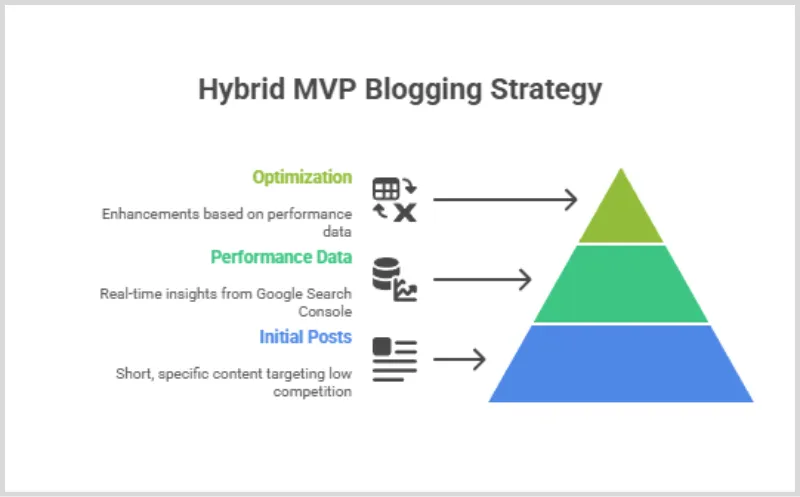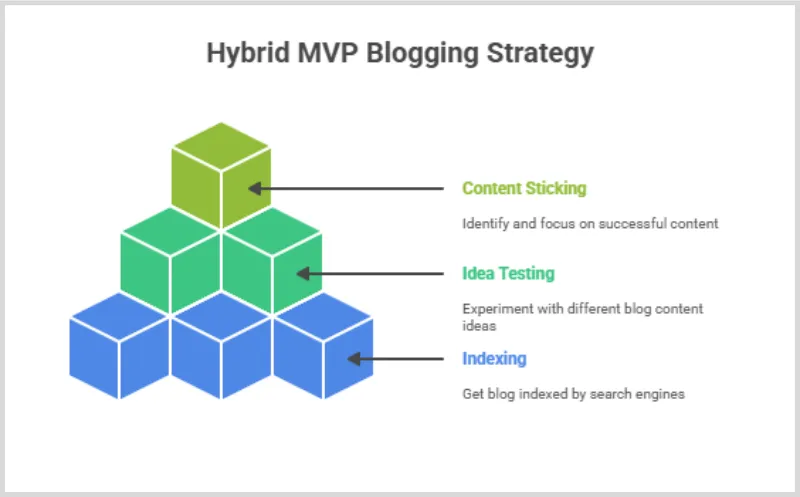Old-school blogging? Honestly, it’s not cutting it anymore. Writing 2,000 words of fluff and hoping Google cares? Good luck with that in 2025.
Enter the Hybrid MVP strategy – a lean, fast, and data-first way to blog. It borrows the “Minimum Viable Product” concept from startup culture and applies it to content.
Instead of writing big, bloated blog posts, you publish short, intent-focused answers to real questions people are Googling. Then you watch the data and improve what works.
It’s basically: publish fast, learn fast, grow what ranks.
Want your content to actually get noticed by AI? Check out our guide on ‘How to Get Your Content Cited by ChatGPT‘ and turn your posts into authority magnets.
What Is the Hybrid MVP Blogging Strategy?
The Hybrid MVP model is simple. You publish short blog posts. Each post targets one low-competition keyword. Posts are short but helpful. After publishing, you watch how they perform in Google Search Console. Then, you improve what works best.

It’s not about writing less; it’s about writing smarter, faster, and with data feedback loops.
Why Hybrid MVP Works in 2025 and Beyond?
We’re drowning in AI content. It’s not rare anymore. What’s rare now is trust and relevance. Google isn’t rewarding the longest article anymore – it’s rewarding the one that hits the searcher’s intent fast and clean.
Here’s why this works:
- You match what the searcher actually wants
- You answer questions quickly
- You publish regularly (Google loves that)
- You adjust based on real data, not guesswork
So yeah, this approach checks all the boxes Google’s paying attention to — especially on low-competition, long-tail keywords.
How to Start a Blog with the Hybrid MVP Model?
No, you don’t need to be an SEO expert. But you do need to think like a startup: move fast, learn on the go, and improve based on feedback.

Start small. Don’t aim for perfection. Your goal in the beginning is simple: get indexed, test ideas, and see what sticks.
How to Find Ultra-Niche, Long-Tail Keywords (100+ Ideas)
You’re not looking for big volume here – you’re looking for easy wins. Target keywords that have:
- Very low competition
- Low to medium volume (even 10–30/month is fine)
- High intent, usually question-based or how-to queries
Examples:
- can I eat banana on keto
- how to clean copper jewelry
- how to fix loose HDMI port on laptop
Use tools like LowFruits, Keyword Chef, or just play around with Google Autosuggest and extensions like Keywords Everywhere.
Pro tip? Filter for keywords where forums like Reddit or Quora are ranking – that means low competition.
How to Write Short Blog Posts That Rank?
Forget the 2,000-word essays. At the MVP stage, you’re writing micro-posts – just enough to answer the question directly.
Structure it like this:
- Quick intro (1–2 lines max)
- Bullet points or short steps with the actual answer
- One-line outro
Example:
Making tea? Easy – here’s what you do:
- Boil a cup of water
- Add 1 tsp tea or a tea bag
- Steep for 2–3 mins
- Add milk/sugar if you want
- Done.
You’re not trying to impress anyone – just help them fast.
How Many Blog Posts Should You Publish Per Day with MVP?
Sounds crazy, but:
Aim for 14–15 micro-posts per day for the first week.
Yes, that’s a lot. But remember:
- Posts are short (100–150 words)
- You’re skipping design, backlinks, and formatting
- Your job is to flood Google with content and test what hits
It’s like throwing 100 darts at the board and seeing which one’s land close to the bullseye.
When to Check Google Search Console for Results
About 7–10 days after publishing, check in with GSC. Go to Performance > Search results, sort by impressions.

Focus on:
- Keywords getting 20+ impressions
- Positions in the 8–20 range (you’re close to top 10)
These are your signals. They tell you what Google’s noticing and what people are actually searching.
How to Optimize MVP Blog Posts for Better Rankings
Once you’ve identified posts that are showing signs of life, it’s time to level them up:
- Expand to 500–700 words
- Add subheadings, FAQs, internal links
- Toss in relevant visuals
- Try to grab featured snippets with clean formatting and clear answers
Basically, you’re taking your MVP and turning it into an actual contender.
Should You Keep Publishing After Optimizing?
Yes – but slow it down a bit.
Suggested content pace:
- Week 2: 13 posts/day
- Week 3: 10/day
- Week 4: 5/day
Why? Because you’re now splitting your time between writing new stuff and optimizing old winners. But never stop completely. Google loves seeing a site that stays alive.
How Long Does It Take to See SEO Results with MVP Blogging?
Rough timeline if you’re doing it right:
- Week 1: You’re indexed, content is live
- Week 2: Some keywords start showing impressions
- Week 3–4: Rankings start to climb
- Week 5+: Real traffic, authority signals, and keyword wins
Some sites hit 1,000 monthly visitors in their first 6–8 weeks. No backlinks. No budget. Just smart publishing.
Can You Use AI to Write MVP Blog Posts?
Yep, totally. But please – edit them. Don’t just paste ChatGPT output and call it done.
Make sure:
- The info is correct
- The tone feels human
- The structure is helpful and natural
Google doesn’t mind AI content – it just wants useful content.
Do You Need Backlinks for MVP Blogging to Work?
Nope. This strategy is designed to work without backlinks – because you’re targeting keywords that no one else is really trying for.
Once your traffic grows, you can build backlinks to scale further, but it’s optional.
What If Your Blog Posts Don’t Get Impressions?
Then your keywords probably suck – or your site isn’t indexed.
Here’s what to check:
- Are your pages in Google’s index?
- Are your keywords too competitive?
- Is your content actually helpful and clear?
If needed, go even lower in competition. Don’t chase shiny keywords. You’re hunting for openings.
When Should You Start Optimizing Your Blog Posts?
Usually around day 7–10. That’s when Google starts giving you early feedback via Search Console.
Any post that’s ranking in the top 20? That’s your cue to upgrade it.
How Can You Monetize a Hybrid MVP Blog?
Once you’re getting steady traffic, you can do stuff like:
- Display ads (AdSense, Ezoic, etc.)
- Affiliate links (Amazon, niche programs)
- Info products (PDFs, eBooks, templates)
- Even sell services or sponsored content
But don’t worry about that early on. First: build traction. Then: monetize.
Final Thoughts
100%. Especially if you:
- Have no budget
- Don’t want to do link building
- Are testing niche ideas fast
- Prefer working smart, not hard
It’s not about writing less – it’s about writing only what matters, shipping fast, and letting Google show you what to grow.
Launch lean. Optimize what works. Ignore the rest. That’s Hybrid MVP.

